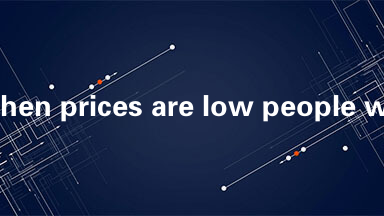
When prices are low people will buy more,and when prices are high they will buy less.Every shopkeeper knows this.But at the same time,producers want higher prices for their goods when they make more goods.How can we find the best price for the goods?The Law of Supply and Demand is the economist’s answer to this question.
According to this law,changes in the prices of goods cause changes in supply and demand.An increase in the price of the goods causes an increase in supply—the number of goods the producers make.Producers will make more goods when they can get higher prices for the goods.The producer makes more shoes as the price of shoes goes up.At the same time,an increase in the price of the goods causes a decrease in demand—the number of goods the consumers buy.This is because people buy less when the price is high.People buy fewer shoes as the price of shoes goes up.Conversely,a decrease in the price causes an increase in demand(people buy more shoes)and a decrease in supply(producers make fewer shoes).
Business firms look at both supply and demand when they make decisions about prices and production.They look for the equilibrium point where supply equals demand.At this point,the number of shoes produced is 3 000 and the price of the shoes is$30.$30 is the equilibrium price:at this price the consumers will buy all of the 3 000 shoes which the producers make.If the producers increase the price of the shoes,or if they produce more than 3 000 shoes,the consumers will not buy all of the shoes.The producers will have a surplus(过剩)—more supply than demand—so they must decrease the price in order to sell all of the shoes.On the other hand,if they make fewer than 3 000 shoes,there will be a shoes shortage—more demand than supply—and the price will go up.
According to the Law of Supply and Demand,the equilibrium price is the best price for the goods.The consumers and the producers will agree on this price because it is the only price that helps them both equally.
41.Why does an increase in price cause an increase in supply?
A.Consumers buy more goods when prices are high.
B.Producers make more goods when prices are high.
C.Producers want to sell all of their goods.
D.Consumers will not buy all of the goods.
42.Why does a decrease in prices cause an increase in demand?
A.Consumers buy fewer goods when prices are low.
B.Producers make fewer goods when prices are low.
C.Producers make more goods when prices are high.
D.Consumers buy more goods when prices are low.
43.What do business firms look at when they make decisions about prices and production?
A.The supply curve.
B.The demand curve.
C.The equilibrium point.
D.All of the above.
44.Why will consumers and producers agree on the equilibrium price?
A.Because it will help them both equally.
B.Because it is the only price for the goods.
C.Because it is the lowest price.
D.Because all of the goods will be sold.
45.When will producers have a surplus of goods?
A.When supply equals demand.
B.When there is more supply than demand.
C.When there is more demand than supply.
D.When they sell all of their goods.
答案
B, D, C, A, B
解析
考点名称:政治经济类阅读
政治经济类文章的概念:
要做好这类阅读,平时就要注意了解国内外发生的政治经济大事,掌握一定背景知识,对这类文章的叙述特点及内容安排有一定了解,还要扩展这方面的词汇。阅读这类文章,要抓住文章的核心,即文章整体和各段主要在说什么,也要注意段落之间的逻辑关系。
如何备考政治经济类阅读理解题:
【题型说明】政治经济类阅读文章是高考常选材料之一。该类文章时代气息浓郁,语言鲜活,但熟字新义词、超纲词及专业词语多,长句、难句多。政治类文章大多数是同学们感性趣的内容,读起来倒有似曾相识的感觉,经济类文章读起来就像是雾里看花,文章看完,一头雾水。再加之这类文章的命题侧重于词义猜测、推理判断和文章主旨,同学们对这类题材是望而生畏。
【备考策略】建立心理优势。针对不同体裁的文章,我们要采取相应的阅读方法和技巧。政治类文章多采用记叙文形式,我们可采取“顺读法”,以便抓关键语句,领会文章主旨;而经济类文章则多采用说明文形式,我们则可以采取“逆读法”,先读试题,再从文章中查找有用信息。若遇到的确难读的材料。千万不用着急,因为你觉得难,其他人也一定是同感。在高考前,我们就要有这种心理准备,高考试卷肯定有一、两篇难以阅读的材料。不过,我们平时可以有意识地从报刊杂志上找一些较难的阅读材料来阅读,以培养自己迎难而上的心理素质。
【答题方法】
1、寻找主干:
根据英语中五种基本句型结构,把句子中的主语、谓语、宾语、表语等主要成分找出来,其他成分如定语、状语、补语等则易于理解。找到了句子主干,句子的意思至少明白了一半。
2、剔除从句:
在一个长句中可能会出现若干个从句,在理解时,如果把各个从句剔除出来单独理解,然后把大意拼凑起来,整个长句的意思就会明白六、七分。
3、辨别分句:
一个长句如果是由几个并列、转折、递进、对比关系的分句组成,句中往往有表示这些分句关系的连接词,只要能弄清楚分句和分句之间的逻辑关系,再把各层分句的意思加以连贯,整个长句的句意基本上能跃然脑中。
4、寻找关键词:
如果一个句子看完,一点句意的感觉也没有,下下策就是抓住句中的关键词,通过关键词大体弄懂这个长句的意思。